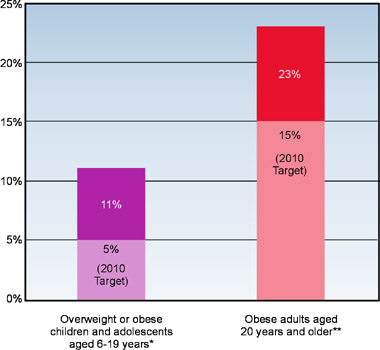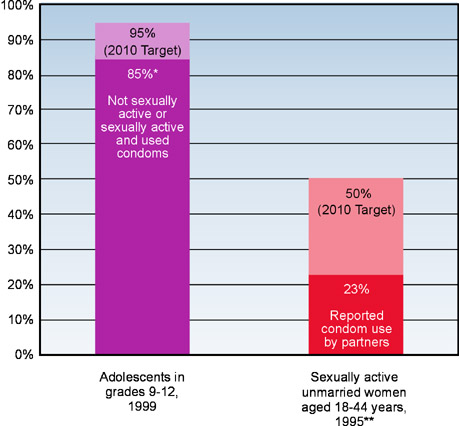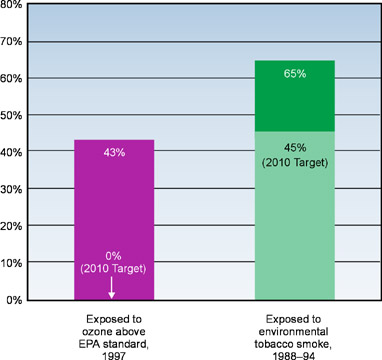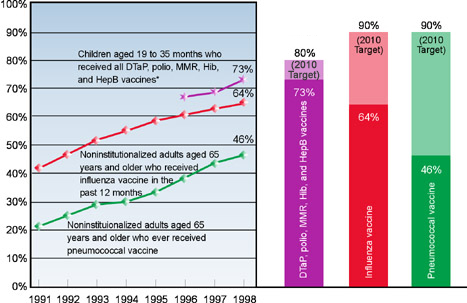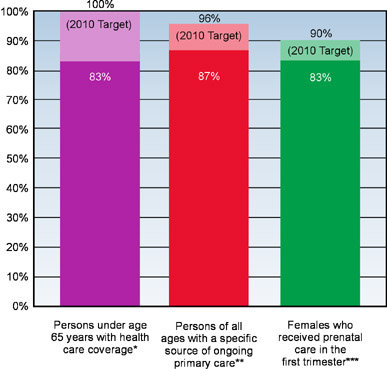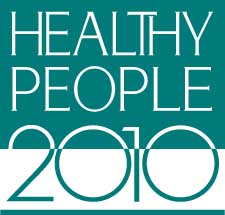
Leading Health Indicators
| ||||||||||||||||||||||||||||||||||||
The Leading Health Indicators reflect the major public health concerns in the United States and were chosen based on their ability to motivate action, the availability of data to measure their progress, and their relevance as broad public health issues.
The Leading Health Indicators illuminate individual behaviors, physical and social environmental factors, and important health system issues that greatly affect the health of individuals and communities. Underlying each of these indicators is the significant influence of income and education (see Income and Education, page 12).
The process of selecting the Leading Health Indicators mirrored the collaborative and extensive efforts undertaken to develop Healthy People 2010. The process was led by an interagency work group within the U.S. Department of Health and Human Services. Individuals and organizations provided comments at national and regional meetings or via mail and the Internet. A report by the Institute of Medicine, National Academy of Sciences, provided several scientific models on which to support a set of indicators. Focus groups were used to ensure that the indicators are meaningful and motivating to the public.
For each of the Leading Health Indicators, specific objectives derived from Healthy People 2010 will be used to track progress. This small set of measures will provide a snapshot of the health of the Nation. Tracking and communicating progress on the Leading Health Indicators through national- and State-level report cards will spotlight achievements and challenges in the next decade. The Leading Health Indicators serve as a link to the 467 objectives in Healthy People 2010 and can become the basic building blocks for community health initiatives.
|
A major challenge throughout the history of Healthy People has been to balance a comprehensive set of health objectives with a smaller set of health priorities. |
The Leading Health Indicators are intended to help everyone more easily understand the importance of health promotion and disease prevention and to encourage wide participation in improving health in the next decade. Developing strategies and action plans to address one or more of these indicators can have a profound effect on increasing the quality of life and the years of healthy life and on eliminating health disparities—creating healthy people in healthy communities.
Physical Activity
Leading Health Indicator
Regular physical activity throughout life is important for maintaining a healthy body, enhancing psychological well-being, and preventing premature death.
In 1999, 65 percent of adolescents engaged in the recommended amount of physical activity. In 1997, only 15 percent of adults performed the recommended amount of physical activity, and 40 percent of adults engaged in no leisure-time physical activity.
The objectives selected to measure progress among adolescents and adults for this Leading Health Indicator are presented below. These are only indicators and do not represent all the physical activity and fitness objectives included in Healthy People 2010.
|
||||||||||||||
Health Impact of Physical Activity
Regular physical activity is associated with lower death rates for adults of any age, even when only moderate levels of physical activity are performed. Regular physical activity decreases the risk of death from heart disease, lowers the risk of developing diabetes, and is associated with a decreased risk of colon cancer. Regular physical activity helps prevent high blood pressure and helps reduce blood pressure in persons with elevated levels.
Regular physical activity also:
n |
Increases muscle and bone strength. | ||
n |
Increases lean muscle and helps decrease body fat. | ||
n |
Aids in weight control and is a key part of any weight loss effort. | ||
n |
Enhances psychological well-being and may even reduce the risk of developing depression. | ||
n |
Appears to reduce symptoms of depression and anxiety and to improve mood. |
In addition, children and adolescents need weight-bearing exercise for normal skeletal development, and young adults need such exercise to achieve and maintain peak bone mass. Older adults can improve and maintain strength and agility with regular physical activity. This can reduce the risk of falling, helping older adults maintain an independent living status. Regular physical activity also increases the ability of people with certain chronic, disabling conditions to perform activities of daily living.
Populations With Low Rates of Physical Activity
n |
Women generally are less active than men at all ages. | ||
n |
People with lower incomes and less education are typically not as physically active as those with higher incomes and education. | ||
n |
African Americans and Hispanics are generally less physically active than whites. | ||
n |
Adults in northeastern and southern States tend to be less active than adults in North-Central and Western States. | ||
n |
People with disabilities are less physically active than people without disabilities. | ||
n |
By age 75, one in three men and one in two women engage in no regular physical activity. |
Other Issues
The major barriers most people face when trying to increase physical activity are lack of time, lack of access to convenient facilities, and lack of safe environments in which to be active.
For more information on Healthy People 2010 objectives or on physical activity and fitness, visit http://www.health.gov/healthypeople/ or call 1-800-367-4725.
Overweight and Obesity
Leading Health Indicator
Overweight and obesity are major contributors to many preventable causes of death. On average, higher body weights are associated with higher death rates. The number of overweight children, adolescents, and adults has risen over the past four decades. Total costs (medical cost and lost productivity) attributable to obesity alone amounted to an estimated $99 billion in 1995.
During 1988–94, 11 percent of children and adolescents aged 6 to 19 years were overweight or obese. During the same years, 23 percent of adults aged 20 years and older were considered obese.
The objectives selected to measure progress among children, adolescents, and adults for this Leading Health Indicator are presented below. These are only indicators and do not represent all the nutrition and overweight objectives included in Healthy People 2010.
|
||||||||||||||||||
Health Impact of Overweight and Obesity
Overweight and obesity substantially raise the risk of illness from high blood pressure, high cholesterol, type 2 diabetes, heart disease and stroke, gallbladder disease, arthritis, sleep disturbances and problems breathing, and certain types of cancers. Obese individuals also may suffer from social stigmatization, discrimination, and lowered self-esteem.
Populations With High Rates of Overweight and Obesity
More than half of adults in the United States are estimated to be overweight or obese. The proportion of adolescents from poor households who are overweight or obese is twice that of adolescents from middle- and high-income households. Obesity is especially prevalent among women with lower incomes and is more common among African American and Mexican American women than among white women. Among African Americans, the proportion of women who are obese is 80 percent higher than the proportion of men who are obese. This gender difference also is seen among Mexican American women and men, but the percentage of white, non-Hispanic women and men who are obese is about the same.
Reducing Overweight and Obesity
Obesity is a result of a complex variety of social, behavioral, cultural, environmental, physiological, and genetic factors. Efforts to maintain a healthy weight should start early in childhood and continue throughout adulthood, as this is likely to be more successful than efforts to lose substantial amounts of weight and maintain weight loss once obesity is established.
A healthy diet and regular physical activity are both important for maintaining a healthy weight. Over time, even a small decrease in calories eaten and a small increase in physical activity can help prevent weight gain or facilitate weight loss. It is recommended that obese individuals who are trying to lose substantial amounts of weight seek the guidance of a health care provider.
Dietary and Physical Activity Recommendations
The Dietary Guidelines for Americans recommend that to build a healthy base, persons aged 2 years and older choose a healthful assortment of foods that includes vegetables; fruits; grains (especially whole grains); fat-free or low-fat milk products; and fish, lean meat, poultry, or beans. The guidelines further emphasize the importance of choosing foods that are low in saturated fat and added sugars most of the time and, whatever the food, eating a sensible portion size. It is recognized, however, that this guidance may be particularly challenging when eating out because the consumer may be offered large portion sizes with unknown amounts of saturated fat and added sugars.
The Dietary Guidelines for Americans recommend that all adults be more active throughout the day and get at least 30 minutes of moderate physical activity most, or preferably all, days of the week. Adults who are trying to maintain healthy weight after weight loss are advised to get even more physical activity. The guidelines also recommend that children get at least 60 minutes of physical activity daily and limit inactive forms of play such as television watching and computer games.
For more information on Healthy People 2010 objectives or on overweight and obesity, visit http://www.health.gov/healthypeople/ or call 1-800-367-4725.
Tobacco Use
Leading Health Indicator
Cigarette smoking is the single most preventable cause of disease and death in the United States. Smoking results in more deaths each year in the United States than AIDS, alcohol, cocaine, heroin, homicide, suicide, motor vehicle crashes, and fires—combined.
Tobacco-related deaths number more than 430,000 per year among U.S. adults, representing more than 5 million years of potential life lost. Direct medical costs attributable to smoking total at least $50 billion per year.
In 1999, 35 percent of adolescents were current cigarette smokers. In 1998, 24 percent of adults were current cigarette smokers.
The objectives selected to measure progress among adolescents and adults for this Leading Health Indicator are presented below. These are only indicators and do not represent all the tobacco use objectives included in Healthy People 2010.
|
||||||||||||||
Health Impact of Cigarette Smoking
Smoking is a major risk factor for heart disease, stroke, lung cancer, and chronic lung diseases—all leading causes of death. Smoking during pregnancy can result in miscarriages, premature delivery, and sudden infant death syndrome. Other health effects of smoking result from injuries and environmental damage caused by fires.
Environmental tobacco smoke (ETS) increases the risk of heart disease and significant lung conditions, especially asthma and bronchitis in children. ETS is responsible for an estimated 3,000 lung cancer deaths each year among adult nonsmokers.
Trends in Cigarette Smoking
Adolescents. Overall, the percentage of adolescents in grades 9 through 12 who smoked in the past month increased in the 1990s. Every day, an estimated 3,000 young persons start smoking. These trends are disturbing because the vast majority of adult smokers tried their first cigarette before age 18 years; more than half of adult smokers became daily smokers before this same age. Almost half of adolescents who continue smoking regularly will die eventually from a smoking-related illness.
Adults. Following years of steady decline, rates of smoking among adults appear to have leveled off in the 1990s.
Populations With High Rates of Smoking
Adolescents. Adolescent rates of cigarette smoking have increased in the 1990s among white, African American, and Hispanic high school students after years of declining rates during the 1970s and 1980s. In 1999, 39 percent of white high school students currently smoked cigarettes compared with 33 percent for Hispanics and 20 percent for African Americans. Among African Americans in 1999, only 19 percent of high school girls, compared with 22 percent of boys, currently smoked cigarettes.
Adults. Overall, American Indians and Alaska Natives, blue-collar workers, and military personnel have the highest rates of smoking in adults. Rates of smoking in Asian and Pacific Islander men are more than four times higher than for women of the same race. Men have only somewhat higher rates of smoking than women within the total U.S. population. Low-income adults are more likely to smoke than are high-income adults. The percentage of people aged 25 years and older with less than 12 years of education who are current smokers is nearly three times that for persons with 16 or more years of education.
Other Important Tobacco Issues
There is no safe tobacco alternative to cigarettes. Spit tobacco (chew) causes cancer of the mouth, inflammation of the gums, and tooth loss. Cigar smoking causes cancer of the mouth, throat, and lungs and can increase the risk of heart disease and chronic lung problems.
For more information on Healthy People 2010 objectives or on
tobacco use, visit
http://www.health.gov/healthypeople/
or call 1-800-367-4725.
Substance Abuse
Leading Health Indicator
Alcohol and illicit drug use are associated with many of this country’s most serious problems, including violence, injury, and HIV infection. The annual economic costs to the United States from alcohol abuse were estimated to be $167 billion in 1995, and the costs from drug abuse were estimated to be $110 billion.
In 1998, 79 percent of adolescents aged 12 to 17 years reported that they did not use alcohol or illicit drugs in the past month. In the same year, 6 percent of adults aged 18 years and older reported using illicit drugs in the past month; 17 percent reported binge drinking in the past month, which is defined as consuming five or more drinks on one occasion.
The objectives selected to measure progress among adolescents and adults for this Leading Health Indicator are presented below. These are only indicators and do not represent all the substance abuse objectives in Healthy People 2010.
|
||||||||||||||||||||
Health Impact of Substance Abuse
Alcohol and illicit drug use are associated with child and spousal abuse; sexually transmitted diseases, including HIV infection; teen pregnancy; school failure; motor vehicle crashes; escalation of health care costs; low worker productivity; and homelessness. Alcohol and illicit drug use also can result in substantial disruptions in family, work, and personal life.
Alcohol abuse alone is associated with motor vehicle crashes, homicides, suicides, and drowning—leading causes of death among youth. Long-term heavy drinking can lead to heart disease, cancer, alcohol-related liver disease, and pancreatitis. Alcohol use during pregnancy is known to cause fetal alcohol syndrome, a leading cause of preventable mental retardation.
Trends in Substance Abuse
Adolescents. Although the trend from 1994 to 1998 has shown some fluctuations, about 77 percent of adolescents aged 12 to 17 years report being both alcohol free and drug free in the past month.
Alcohol is the drug most frequently used by adolescents aged 12 to 17 years. In 1998, 19 percent of adolescents aged 12 to 17 years reported drinking alcohol in the past month. Alcohol use in the past month for this age group has remained at about 20 percent since 1992. Eight percent of this age group reported binge drinking, and 3 percent were heavy drinkers (five or more drinks on the same occasion on each of 5 or more days in the past 30 days).
Data from 1998 show that 10 percent of adolescents aged 12 to 17 years reported using illicit drugs in the past 30 days. This rate remains well below the all-time high of 16 percent in 1979. Current illicit drug use had nearly doubled for those aged 12 to 13 years between 1996 and 1997 but then decreased between 1997 and 1998. Youth are experimenting with a variety of illicit drugs, including marijuana, cocaine, crack, heroin, acid, inhalants, and methamphetamines, as well as misuse of prescription drugs and other “street” drugs. The younger a person becomes a habitual user of illicit drugs, the stronger the addiction becomes and the more difficult it is to stop use.
Adults. Binge drinking has remained at the same approximate level of 17 percent for all adults since 1988, with the highest current rate of 32 percent among adults aged 18 to 25 years. Illicit drug use has been near the present rate of 6 percent since 1980. Men continue to have higher rates of illicit drug use than women have, and rates of illicit drug use in urban areas are higher than in rural areas.
For more information on Healthy People 2010 objectives or on substance abuse, visit http://www.health.gov/healthypeople/ or call 1-800-367-4725.
Responsible Sexual Behavior
Leading Health Indicator
Unintended pregnancies and sexually transmitted diseases (STDs), including infection with the human immunodeficiency virus that causes AIDS, can result from unprotected sexual behaviors. Abstinence is the only method of complete protection. Condoms, if used correctly and consistently, can help prevent both unintended pregnancy and STDs.
In 1999, 85 percent of adolescents abstained from sexual intercourse or used condoms if they were sexually active. In 1995, 23 percent of sexually active women reported that their partners used condoms.
The objectives selected to measure progress among adolescents and adults for this Leading Health Indicator are presented below. These are only indicators and do not represent all the responsible sexual behavior objectives in Healthy People 2010.
|
||||||||||||||||||
Trends in Sexual Behavior
In the past 6 years there has been both an increase in abstinence among all youth and an increase in condom use among those young people who are sexually active. Research has shown clearly that the most effective school-based programs are comprehensive ones that include a focus on abstinence and condom use. Condom use in sexually active adults has remained steady at about 25 percent.
Unintended Pregnancies
Half of all pregnancies in the United States are unintended; that is, at the time of conception the pregnancy was not planned or not wanted. Unintended pregnancy rates in the United States have been declining. The rates remain highest among teenagers, women aged 40 years or older, and low-income African American women. Approximately 1 million teenage girls each year in the United States have unintended pregnancies. Nearly half of all unintended pregnancies end in abortion.
The cost to U.S. taxpayers for adolescent pregnancy is estimated at between $7 billion and $15 billion a year.
Sexually Transmitted Diseases
Sexually transmitted diseases are common in the United States, with an estimated 15 million new cases of STDs reported each year. Almost 4 million of the new cases of STDs each year occur in adolescents. Women generally suffer more serious STD complications than men, including pelvic inflammatory disease, ectopic pregnancy, infertility, chronic pelvic pain, and cervical cancer from the human papilloma virus. African Americans and Hispanics have higher rates of STDs than whites.
The total cost of the most common STDs and their complications is conservatively estimated at $17 billion annually.
HIV/AIDS
Nearly 700,000 cases of AIDS have been reported in the United States since the HIV/AIDS epidemic began in the 1980s. The latest estimates indicate that 800,000 to 900,000 people in the United States currently are infected with HIV. The lifetime cost of health care associated with HIV infection, in light of recent advances in HIV diagnostics and therapies, is $155,000 or more per person.
About one-half of all new HIV infections in the United States are among people under age 25 years, and the majority are infected through sexual behavior. HIV infection is the leading cause of death for African American men aged 25 to 44 years. Compelling worldwide evidence indicates that the presence of other STDs increases the likelihood of both transmitting and acquiring HIV infection.
For more information on Healthy People 2010 objectives or on responsible sexual behavior, visit http://www.health.gov/healthypeople/ or call 1-800-367-4725.
Mental Health
Leading Health Indicator
Approximately 20 percent of the U.S. population is affected by mental illness during a given year; no one is immune. Of all mental illnesses, depression is the most common disorder. More than 19 million adults in the United States suffer from depression. Major depression is the leading cause of disability and is the cause of more than two-thirds of suicides each year.
In 1997, only 23 percent of adults diagnosed with depression received treatment.
The objective selected to measure progress among adults for this Leading Health Indicator is presented below. This is only an indicator and does not represent all the mental health objectives in Healthy People 2010.
|
|||||||||||||||
Definition of Mental Health
Mental health is sometimes thought of as simply the absence of a mental illness but is actually much broader. Mental health is a state of successful mental functioning, resulting in productive activities, fulfilling relationships, and the ability to adapt to change and cope with adversity. Mental health is indispensable to personal well-being, family and interpersonal relationships, and one’s contribution to society.
Impact of Depression
A person with a depressive disorder often is unable to fulfill the daily responsibilities of being a spouse, partner, or parent. The misunderstanding of mental illness and the associated stigmatization prevent many persons with depression from seeking professional help. Many people will be incapacitated for weeks or months because their depression goes untreated.
Depression is associated with other medical conditions, such as heart disease, cancer, and diabetes as well as anxiety and eating disorders. Depression also has been associated with alcohol and illicit drug abuse. An estimated 8 million persons aged 15 to 54 years had coexisting mental and substance abuse disorders within the past year.
The total estimated direct and indirect cost of mental illness in the United States in 1996 was $150 billion.
Treatment of Depression
Depression is treatable. Available medications and psychological treatments, alone or in combination, can help 80 percent of those with depression. With adequate treatment, future episodes of depression can be prevented or reduced in severity. Treatment for depression can enable people to return to satisfactory, functioning lives.
Populations With High Rates of Depression
Serious mental illness clearly affects mental health and can affect children, adolescents, adults, and older adults of all ethnic and racial groups, both genders, and people at all educational and income levels.
Adults and older adults have the highest rates of depression. Major depression affects approximately twice as many women as men. Women who are poor, on welfare, less educated, unemployed, and from certain racial or ethnic populations are more likely to experience depression. In addition, depression rates are higher among older adults with coexisting medical conditions. For example, 12 percent of older persons hospitalized for problems such as hip fracture or heart disease are diagnosed with depression. Rates of depression for older persons in nursing homes range from 15 to 25 percent.
For more information on Healthy People 2010 objectives or on mental health, visit http://www.health.gov/healthypeople/ or call 1-800-367-4725.
Injury and Violence
Leading Health Indicator
More than 400 Americans die each day from injuries due primarily to motor vehicle crashes, firearms, poisonings, suffocation, falls, fires, and drowning. The risk of injury is so great that most persons sustain a significant injury at some time during their lives.
Motor vehicle crashes are the most common cause of serious injury. In 1998, there were 15.6 deaths from motor vehicle crashes per 100,000 persons.
Because no other crime is measured as accurately and precisely, homicide is a reliable indicator of all violent crime. In 1998, the murder rate in the United States fell to its lowest level in three decades—6.5 homicides per 100,000 persons.
The objectives selected to measure progress for this Leading Health Indicator are presented below. These are only indicators and do not represent all the injury and violence prevention objectives in Healthy People 2010.
|
||||||||||||||
Impact of Injury and Violence
In 1995, the cost of injury and violence in the United States was estimated at more than $224 billion per year. These costs include direct medical care and rehabilitation as well as productivity losses to the Nation’s workforce. The total societal cost of motor vehicle crashes alone exceeds $150 billion annually.
Motor Vehicle Crashes
Motor vehicle crashes are often predictable and preventable. Increased use of safety belts and reductions in driving while impaired are two of the most effective means to reduce the risk of death and serious injury of occupants in motor vehicle crashes.
Death rates associated with motor vehicle-traffic injuries are highest in the age group 15 to 24 years. In 1996, teenagers accounted for only 10 percent of the U.S. population but 15 percent of the deaths from motor vehicle crashes. Those aged 75 years and older had the second highest rate of motor vehicle-related deaths.
Nearly 40 percent of traffic fatalities in 1997 were alcohol related. Each year in the United States it is estimated that more than 120 million episodes of impaired driving occur among adults. In 1996, 21 percent of traffic fatalities of children aged 14 years and under involved alcohol; 60 percent of the time the driver of the car in which the child was a passenger was impaired.
The highest intoxication rates in fatal crashes in 1995 were recorded for drivers aged 21 to 24 years. Young drivers who have been arrested for driving while impaired are more than four times as likely to die in future alcohol-related crashes.
Homicides
In 1997, 32,436 individuals died from firearm injuries; of this number, 42 percent were victims of homicide. In 1997, homicide was the third leading cause of death for children aged 5 to 14 years, an increasing trend in childhood violent deaths. In 1996, more than 80 percent of infant homicides were considered to be fatal child abuse.
Many factors that contribute to injuries also are closely associated with violent and abusive behavior, such as low income, discrimination, lack of education, and lack of employment opportunities.
Males are most often the victims and the perpetrators of homicides. African Americans are more than five times as likely as whites to be murdered. There has been a decline in the homicide of intimates, including spouses, partners, boyfriends, and girlfriends, over the past decade, but this problem remains significant.
For more information on Healthy People 2010 objectives or on injury and violence, visit http://www.health.gov/healthypeople/ or call 1-800-367-4725.
Environmental Quality
Leading Health Indicator
An estimated 25 percent of preventable illnesses worldwide can be attributed to poor environmental quality. In the United States, air pollution alone is estimated to be associated with 50,000 premature deaths and an estimated $40 billion to $50 billion in health-related costs annually. Two indicators of air quality are ozone (outdoor) and environmental tobacco smoke (indoor).
In 1997, approximately 43 percent of the U.S. population lived in areas designated as nonattainment areas for established health-based standards for ozone. During the years 1988 to 1994, 65 percent of nonsmokers were exposed to environmental tobacco smoke (ETS).
The objectives selected to measure progress among children, adolescents, and adults for this Leading Health Indicator are presented below. These are only indicators and do not represent all the environmental quality objectives in Healthy People 2010.
|
||||||||||||||
Defining the Environment
Physical and social environments play major roles in the health of individuals and communities. The physical environment includes the air, water, and soil through which exposure to chemical, biological, and physical agents may occur. The social environment includes housing, transportation, urban development, land use, industry, and agriculture and results in exposures such as work-related stress, injury, and violence.
Global Concern
Environmental quality is a global concern. Ever-increasing numbers of people and products cross national borders and may transfer health risks such as infectious diseases and chemical hazards. For example, pesticides that are not registered or are restricted for use in the United States potentially could be imported in the fruits, vegetables, and seafood produced abroad.
Health Impact of Poor Air Quality
Poor air quality contributes to respiratory illness, cardiovascular disease, and cancer. For example, asthma can be triggered or worsened by exposure to ozone and ETS. The overall death rate from asthma increased 57 percent between 1980 and 1993, and for children it increased 67 percent.
Air Pollution. Dramatic improvements in air quality in the United States have occurred over the past three decades. Between 1970 and 1997, total emissions of the six principal air pollutants decreased 31 percent. Still, millions of tons of toxic pollutants are released into the air each year from automobiles, industry, and other sources. In 1997, despite continued improvements in air quality, approximately 120 million people lived in areas with unhealthy air based on established standards for one or more commonly found air pollutants, including ozone. In 1996, a disproportionate number of Hispanics and Asian and Pacific Islanders lived in areas that failed to meet these standards compared with whites, African Americans, and American Indians or Alaska Natives.
Tobacco Smoke. Exposure to ETS, or secondhand smoke, among nonsmokers is widespread. Home and workplace environments are major sources of exposure. A total of 15 million children are estimated to have been exposed to secondhand smoke in their homes in 1996. ETS increases the risk of heart disease and respiratory infections in children and is responsible for an estimated 3,000 cancer deaths of adult nonsmokers.
Improvement in Environmental Quality
In the United States, ensuring clean water, safe food, and effective waste management has contributed greatly to a declining threat from many infectious diseases; however, there is still more that can be done. Work to improve the air quality and to understand better threats such as chronic, low-level exposures to hazardous substances also must continue.
For more information on Healthy People 2010 objectives or on environmental quality, visit http://www.health.gov/healthypeople/ or call 1-800-367-4725.
Immunization
Leading Health Indicator
Vaccines are among the greatest public health achievements of the 20th century. Immunizations can prevent disability and death from infectious diseases for individuals and can help control the spread of infections within communities.
In 1998, 73 percent of children received all vaccines recommended for universal administration.
In 1998, influenza immunization rates were 64 percent in adults aged 65 years and older—almost double the 1989 immunization rate of 33 percent. In 1998, only 46 percent of persons aged 65 years and older ever had received a pneumococcal vaccine.
The objectives selected to measure progress among children and adults for this Leading Health Indicator are presented below. These are only indicators and do not represent all the immunization and infectious diseases objectives in Healthy People 2010.
|
||||||||||||||
Impact of Immunization
Many once-common vaccine-preventable diseases now are controlled. Smallpox has been eradicated, poliomyelitis has been eliminated from the Western Hemisphere, and measles cases in the United States are at a record low.
Immunizations against influenza and pneumococcal disease can prevent serious illness and death. Pneumonia and influenza deaths together constitute the sixth leading cause of death in the United States. Influenza causes an average of 110,000 hospitalizations and 20,000 deaths annually; pneumococcal disease causes 10,000 to 14,000 deaths annually.
Recommended Immunizations
As of November 1, 1999, all children born in the United States (11,000 per day) should be receiving 12 to 16 doses of vaccine by age 2 years to be protected against 10 vaccine-preventable childhood diseases. This recommendation will change in the years ahead as new vaccines are developed, including combinations of current vaccines that may even reduce the number of necessary shots.
Recommended immunizations for adults aged 65 years and older include a yearly immunization against influenza (the “flu shot”) and a one-time immunization against pneumococcal disease. Most of the deaths and serious illnesses caused by influenza and pneumococcal disease occur in older adults and others at increased risk for complications of these diseases because of other risk factors or medical conditions.
Trends in Immunization
National coverage levels in children now are greater than 90 percent for each immunization recommended during the first 2 years of life, except for hepatitis B and varicella vaccines. The hepatitis B immunization rate in children was 87 percent in 1998—the highest level ever reported. In 1998, 70 percent of children aged 19 to 35 months from the lowest income households received the combined series of recommended immunizations, compared with 77 percent of children from higher income households.
Both influenza and pneumococcal immunization rates are significantly lower for African American and Hispanic adults than for white adults.
Other Immunization Issues
Coverage levels for immunizations in adults are not as high as those achieved in children, yet the health effects may be just as great. Barriers to adult immunization include not knowing immunizations are needed, misconceptions about vaccines, and lack of recommendations from health care providers.
For more information on Healthy People 2010 objectives or on immunization and infectious diseases, visit http://www.health.gov/healthypeople/ or call 1-800-367-4725.
Access to Health Care
Leading Health Indicator
Strong predictors of access to quality health care include having health insurance, a higher income level, and a regular primary care provider or other source of ongoing health care. Use of clinical preventive services, such as early prenatal care, can serve as indicators of access to quality health care services.
In 1997, 83 percent of all persons under age 65 years had health insurance. In 1998, 87 percent of persons of all ages had a usual source of health care. Also in that year, 83 percent of pregnant women received prenatal care in the first trimester of pregnancy.
The objectives selected to measure progress for this Leading Health Indicator are presented below. These are only indicators and do not represent all the access to quality health services objectives in Healthy People 2010.
|
||||||||||||||||||||
Health Insurance
Health insurance provides access to health care. Persons with health insurance are more likely to have a primary care provider and to have received appropriate preventive care such as a recent Pap test, immunization, or early prenatal care. Adults with health insurance are twice as likely to receive a routine checkup as are adults without health insurance.
More than 44 million persons in the United States do not have health insurance, including 11 million uninsured children. Over the past decade, the proportion of persons under age 65 years with health insurance remained steady at about 85 percent. About one-third of adults under age 65 years below the poverty level were uninsured. For persons of Hispanic origin, approximately one in three was without health insurance coverage in 1997. Mexican Americans had one of the highest uninsured rates at 40 percent.
Ongoing Sources of Primary Care
More than 40 million Americans do not have a particular doctor’s office, clinic, health center, or other place where they usually go to seek health care or health-related advice. Even among privately insured persons, a significant number lacked a usual source of care or reported difficulty in accessing needed care due to financial constraints or insurance problems.
People aged 18 to 24 years were the most likely to lack a usual source of ongoing primary care. Only 80 percent of individuals below the poverty level and 79 percent of Hispanics had a usual source of ongoing primary care.
Barriers to Access
Financial, structural, and personal barriers can limit access to health care. Financial barriers include not having health insurance, not having enough health insurance to cover needed services, or not having the financial capacity to cover services outside a health plan or insurance program. Structural barriers include the lack of primary care providers, medical specialists, or other health care professionals to meet special needs or the lack of health care facilities. Personal barriers include cultural or spiritual differences, language barriers, not knowing what to do or when to seek care, or concerns about confidentiality or discrimination.
For more information on Healthy People 2010 objectives or on access to health care, visit http://www.health.gov/healthypeople/ or call 1-800-367-4725.

